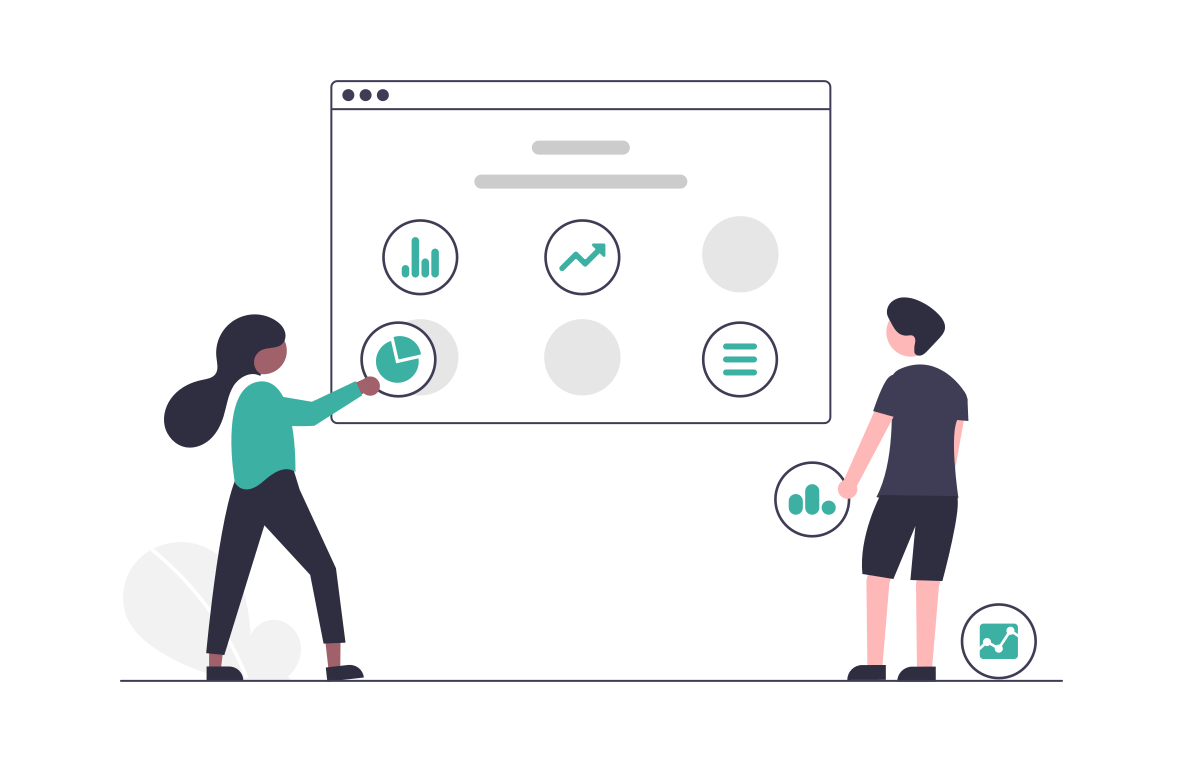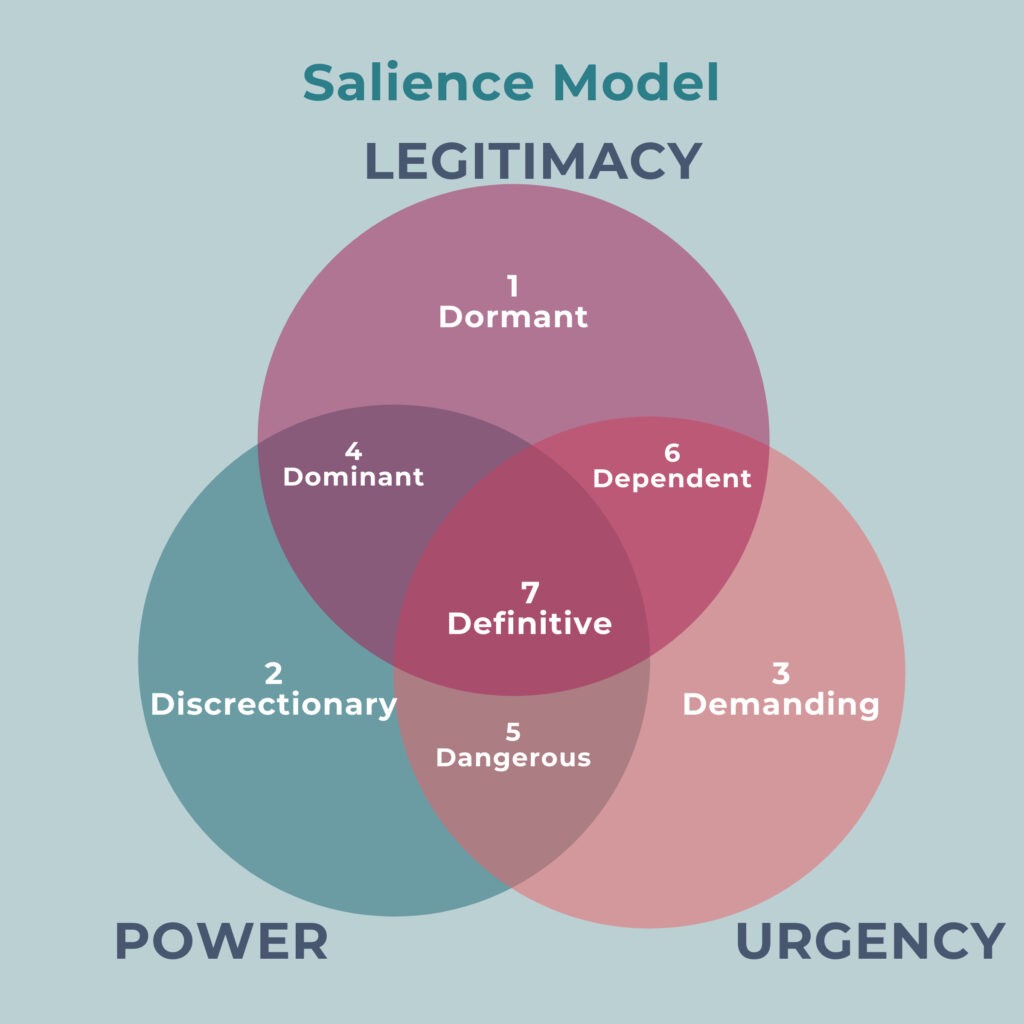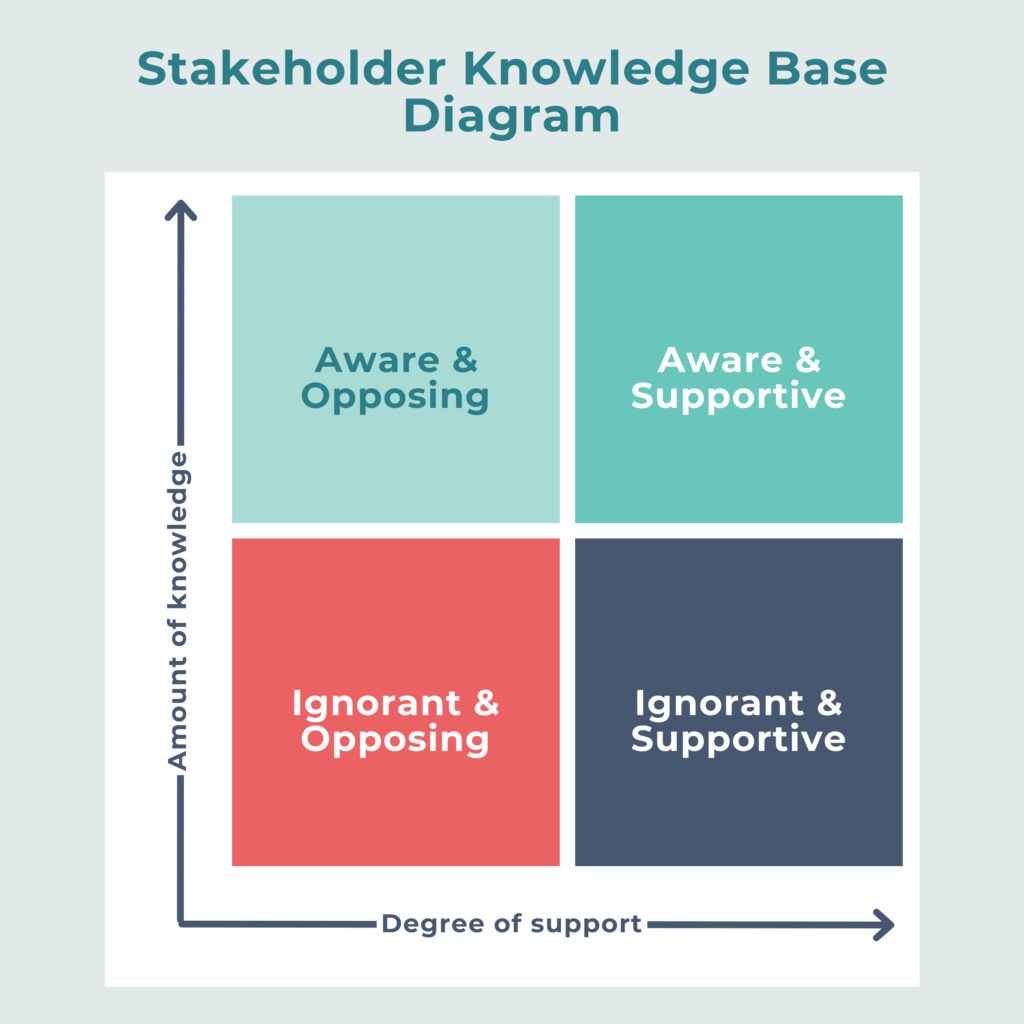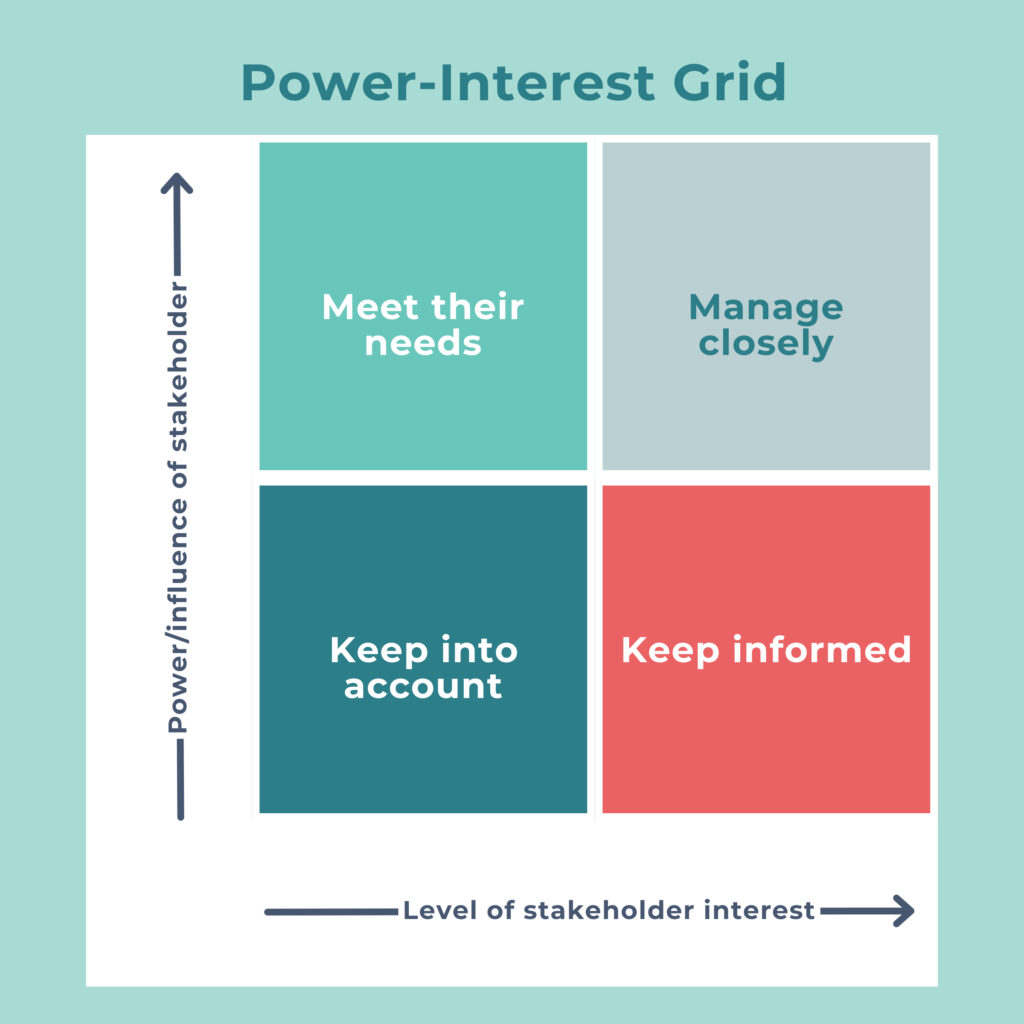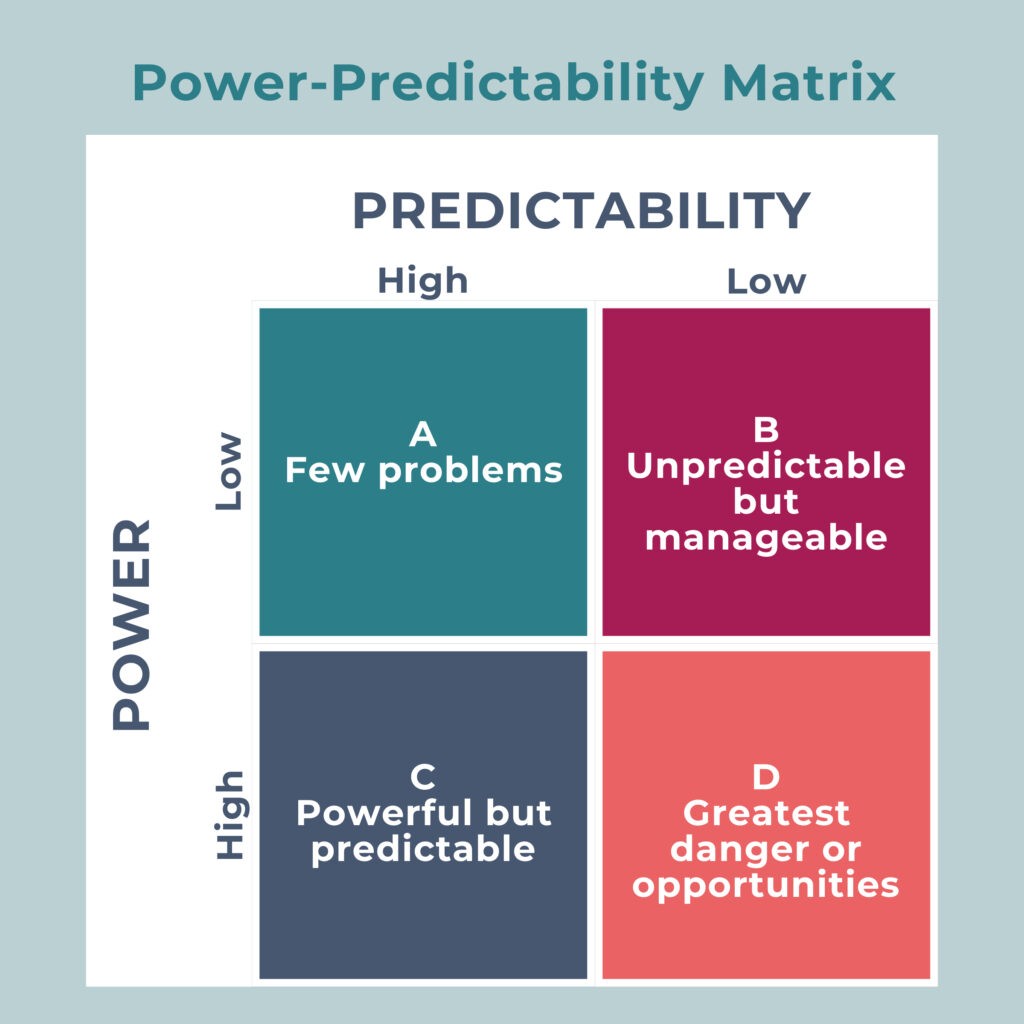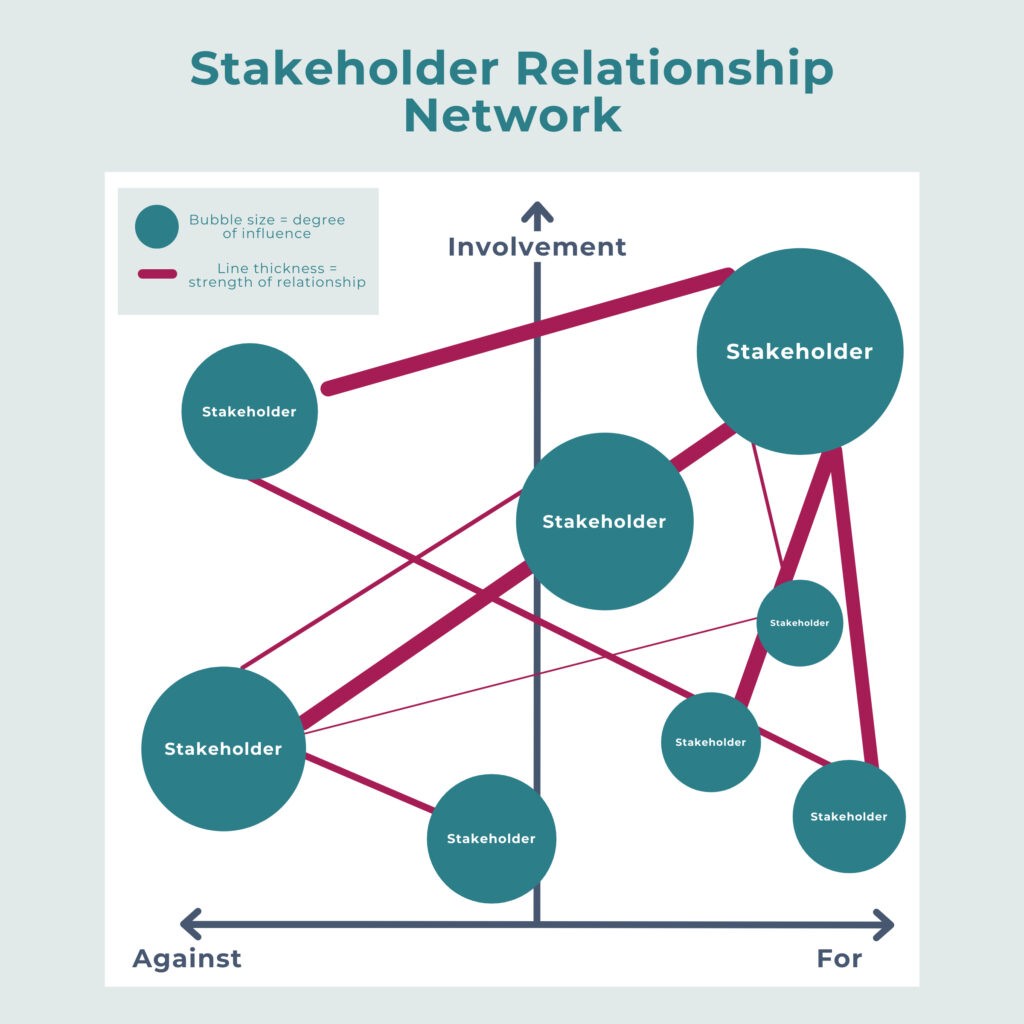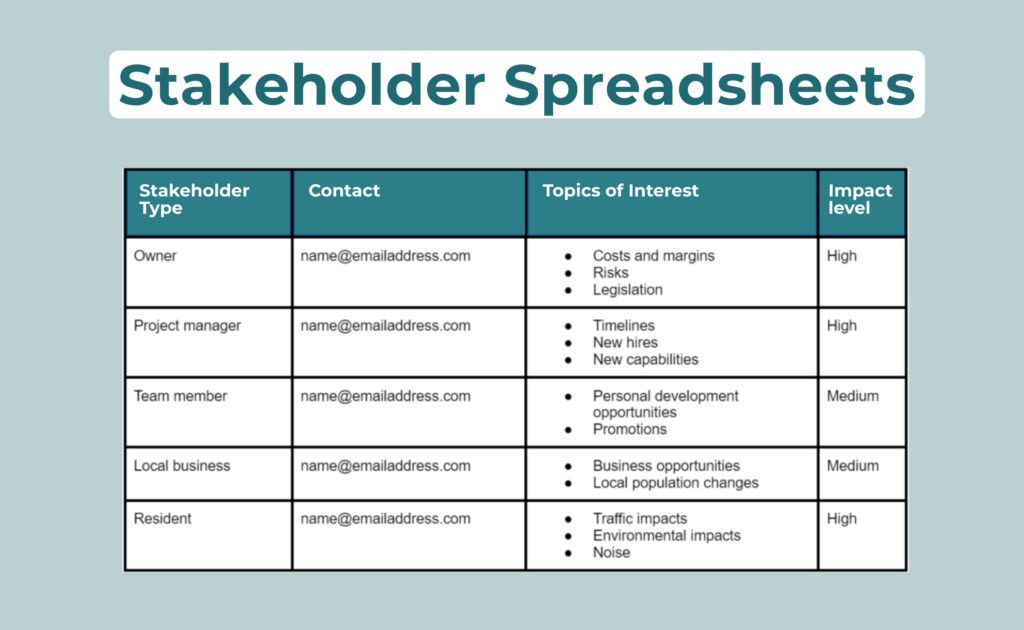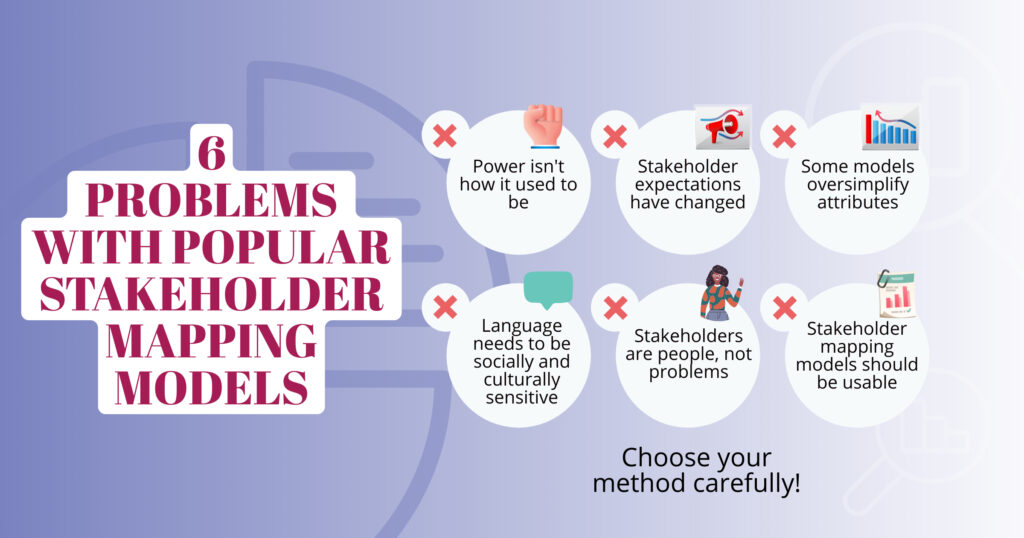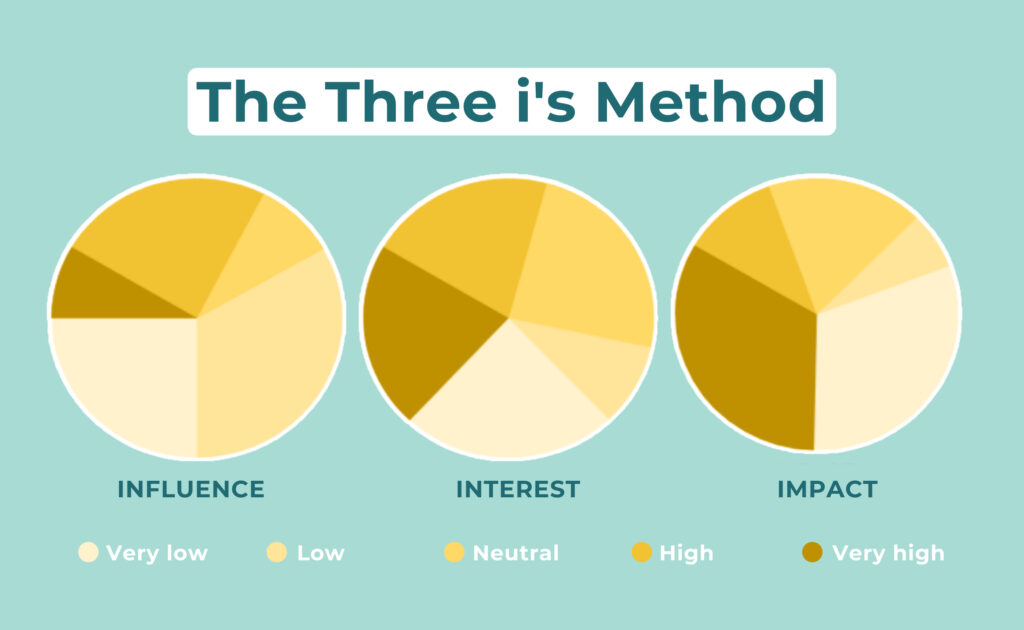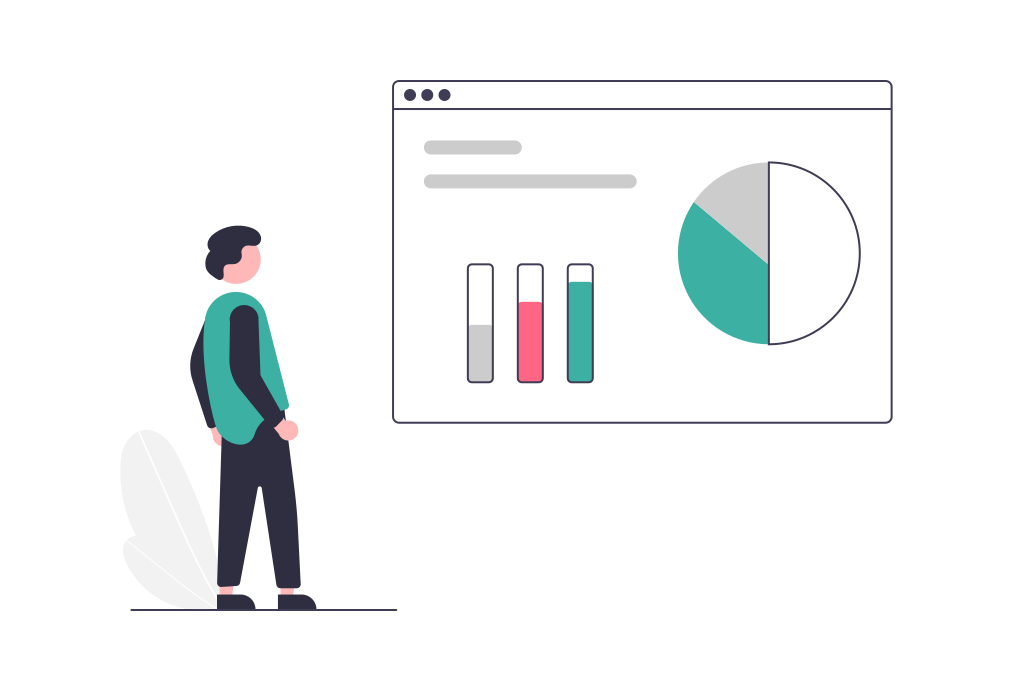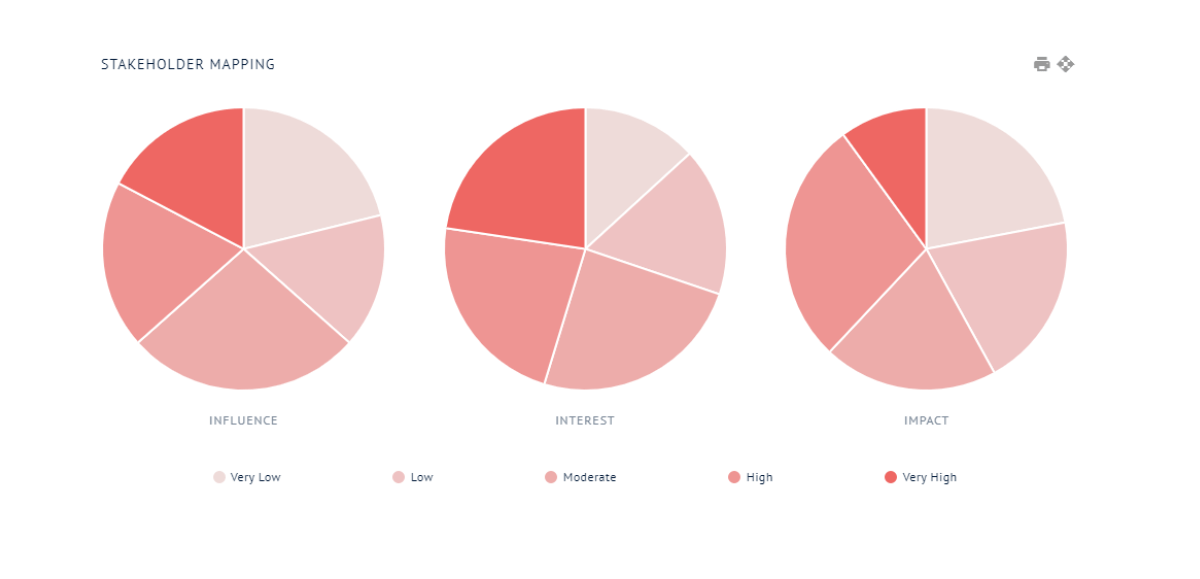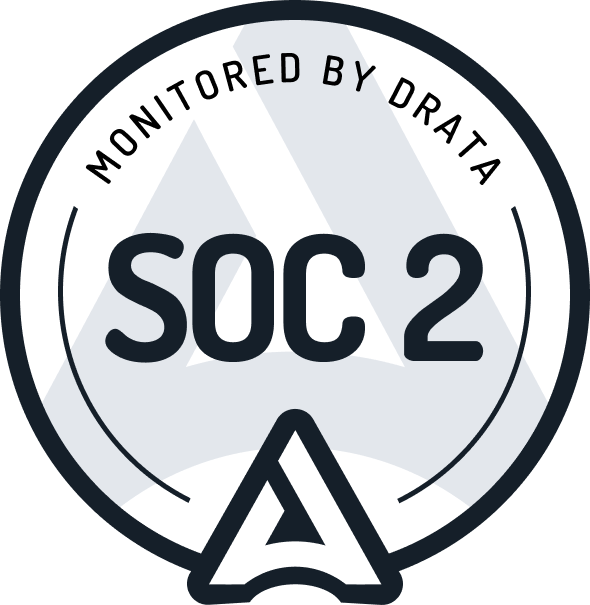Advanced stakeholder management
Stakeholder Mapping: Methods, Benefits & Examples
See a detailed overview of stakeholder mapping, including historical models, their limitations, and a new (and better) way to map your stakeholders.
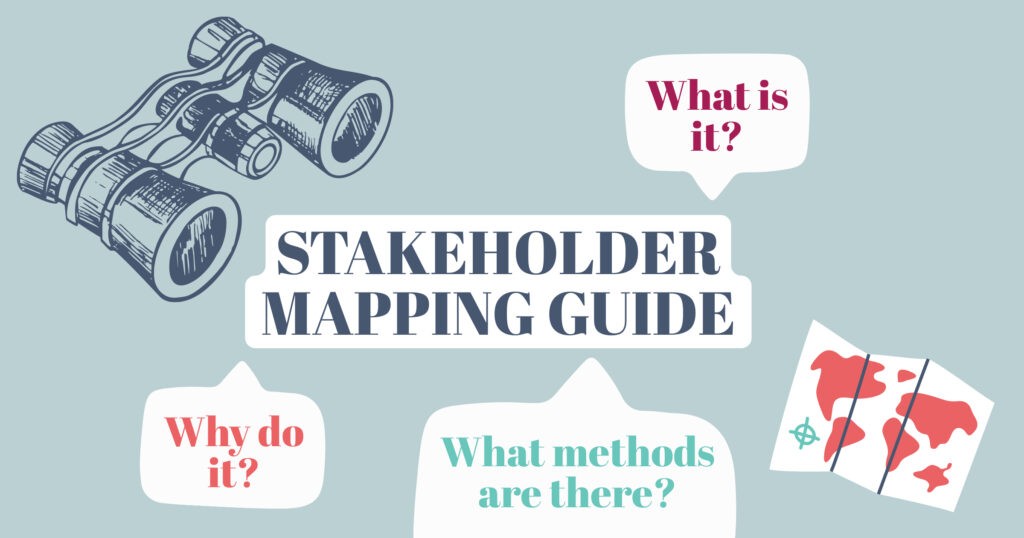
Stakeholder mapping is an important tool for stakeholder professionals and project managers, as it allows us to analyze stakeholders, develop stakeholder management plans, and more effectively engage with stakeholders.
But very few people use stakeholder mapping to its full potential — in part, because the most commonly used stakeholder mapping models are problematic.
So let’s explore the concept of stakeholder mapping, its benefits, the different models of stakeholder mapping, which stakeholder mapping method you should use, and how to improve your stakeholder mapping processes.
What is Stakeholder Mapping?
Stakeholders are the people, groups, or organizations that are impacted by (or have an impact on) your project, organization, or work. Stakeholder mapping is the process of placing your stakeholder attributes onto a chart to visualize the data, compare the position of different stakeholders, and analyze your stakeholders based on the attributes shown.
Learn more about this topic in our articles on the importance of stakeholders and identifying key stakeholders.
Where Does Stakeholder Mapping Fit Into Your Process?
Stakeholder mapping is part of the stakeholder analysis process. And of course, stakeholder analysis is often part of the stakeholder planning, stakeholder engagement, and stakeholder management processes.
What’s Involved in Mapping Stakeholders?
Generally, speaking, stakeholder mapping involves assigning attributes or levels to each stakeholder based on their characteristics in relation to the project or work. For example, you might mark up each stakeholder as being low impact, medium impact, or high impact. But the precise steps and outcomes will depend on what mapping model(s) you choose to use.
Many stakeholder mapping models use charts to visualise all their stakeholder attributes in one place, understand where one stakeholder sits compared to others, identify trends, or organize stakeholders into groups based on shared attributes.
But why go to all this effort?
Benefits of Stakeholder Mapping
When it’s done well, stakeholder mapping can help you better understand and organize your stakeholders, as well as support stakeholder management and engagement objectives, like:
- Managing your social license to operate
- Providing evidence of engagement
- Improving efficiency (i.e. reducing risk and delays)
- Identifying stakeholder interests to support success and avoid conflicts
- Developing a more comprehensive list of potential stakeholders
- Supporting an appropriate frequency of engagement
- Identifying the most effective and efficient engagement strategies
- Measuring how engagement activities impact stakeholders over time
We share more details about the benefits of stakeholder analysis (and by extension, stakeholder mapping) inside our guide to stakeholder analysis.
Who Might Need to do Stakeholder Mapping?
Anyone that needs to manage, engage, or consult with stakeholders could benefit from stakeholder mapping — in order to more effectively understand stakeholders, get organized, and other benefits we already talked about. However, certain types of roles and organizations are more likely to require stakeholder mapping than others due to the nature and complexity of their work. For instance:
- Project Managers – Stakeholder mapping can increase their understanding of different stakeholder attributes to support relationship building, solve problems, and reduce uncertainty.
- Community Engagement Officers – Stakeholder mapping models can help busy community engagement professionals use their time more effectively, with the insights they need to focus on the right community member at the right time (as well as segmenting them into groups).
- Public Consultation Managers – Stakeholder mapping can help a public consultation manager to identify and group any interested groups and individuals so they can keep them informed and engaged.
- Communications Managers – Stakeholder mapping can be a valuable tool and process for communication managers to identify their audience, identify issues that matter to stakeholders, craft messages, determine suitable channels, and segment contacts.
- Product Managers – Product managers will often be tasked with stakeholder identification and engagement – and mapping those stakeholders can help them better understand the specific groups they’re dealing with and identify their needs and goals.
- Leaders of Large Organizations – Stakeholder relationship mapping (in particular) can help leaders identify key stakeholders they can strategically manage and build relationships with.
So, how do you actually do stakeholder mapping?
Common Stakeholder Mapping Models
There are a number of different stakeholder mapping models, but let’s take a look at some of the most common methods used.
1. Salience Model
Salience refers to how prominent or noticeable something or someone is. This stakeholder mapping model is used to classify stakeholders on the attributes of power, legitimacy, and urgency. You can use the venn diagram to show how these attributes intersect, resulting in seven stakeholder groups with varying degrees of power, legitimacy, and urgency.
From there, these seven groups can be assigned to three categories for prioritization.
| Group | Attributes | Example | Priority |
| 1. Dormant | High power, low legitimacy, and low urgency | An executive not currently involved or interested in the project. | Priority 3
With just one salient attribute, these stakeholders often require the least amount of attention, but should be monitored in case their situation changes. |
| 2. Discretionary | High legitimacy, low power, and low urgency | A local environmental group indirectly impacted by the work you’re doing. | |
| 3. Demanding | High urgency, low power, and low legitimacy | Locals that feel strongly about the project even if it doesn’t directly impact them. | |
| 4. Dominant | High power, high legitimacy, and low urgency | Council groups with the authority to approve or deny project plans. | Priority 2
With two salient attributes, these stakeholders will benefit from regular communication and engagement to ensure the project stays on track. |
| 5. Dangerous | High power, high urgency, and low legitimacy | Individuals or groups that (while not directly connected to the project) may create trouble. | |
| 6. Dependant | High urgency, high legitimacy, and low power | Local residents that are unlikely to influence the project (without forming a group or connecting with another stakeholder who has more power). | |
| 7. Definitive | High power, high legitimacy, and high urgency | Leaders of key organizations who are closely involved in the work or project. | Priority 1
As these stakeholders have all attributes, they are your core stakeholder group. Their involvement and communication should be prioritized. |
The idea behind this model is that you can quickly identify which stakeholders may need the most attention. But it does have a number of issues and limitations (more on that later).
2. Stakeholder Knowledge Base Chart
The Stakeholder Knowledge Base Chart, found in Gower Handbook of Project Management, is used for mapping stakeholders based on how much they know about a project and their attitude towards it. It includes the following quadrants:
- Aware / Opposition – These stakeholders may be a risk and require management.
- Aware / Support – These stakeholders are worth keeping informed so they can continue to champion your project or work.
- Ignorant / Opposition – Increasing the understanding of these stakeholders may help to change their attitude.
- Ignorant / Support – Engaging with these stakeholders will help to keep them onboard and strengthen their support.
This approach may be used to tailor communication and engagement strategies to different stakeholder groups, but as we’ll soon see, it has some limitations that are worth considering.
3. Power/Interest Grid
The Power/Interest Grid is used to map stakeholders onto four quadrants, based on their level of power or influence, and their level of interest. Each quadrant requires different actions or levels of engagement:
- High power / high interest – Manage closely, regularly engage, and manage expectations
- High power / low interest – Meet their needs, keep them satisfied, and actively consult
- Low power / low interest – Monitor and provide information as needed
- Low power / high interest – Keep informed and maintain interest
The model suggests that depending on where each stakeholder is positioned, you may need to engage with them more or less frequently, with more or less intensity. It presents a simple way to classify stakeholders and tailor your engagement strategy. But like the other models here, it also has its limitations.
4. Power-Predictability Matrix
The Power/Predictability Matrix is very similar to the Power/Interest Matrix, but has a focus on predictability rather than interest.
People are often unpredictable — but some more than others.
The idea behind this model is that greater levels of unpredictability (combined with higher power) can present more of a challenge in stakeholder management. It is supposed to identify which stakeholders require closer monitoring, higher levels of satisfaction, faster responses, and a more hands-on approach. Once again, this matrix isn’t perfect, and we’ll discuss why below.
5. Stakeholder Relationship Mapping
Stakeholder relationship maps can help you visualize how stakeholders are linked. Some mapping tools allow you to show the strength of relationship and degree of influence, while also placing stakeholders on a scattergram according to other attributes, like their level of involvement, and sentiment.
This can help with understanding power and influence and potential ways to group stakeholders. But it doesn’t cover everything.
6. Stakeholder Mapping Spreadsheets
While you can use software or even pen and paper to map stakeholders onto a grid or chart, a lot of stakeholder mapping is done in spreadsheets. Columns can be added to make note of any attributes, alongside stakeholder contact info. Attributes may include topics of interest, level of impact, positive/negative/neutral sentiment, and more.
This approach offers a lot of flexibility — and spreadsheets are a very accessible tool, but (you guessed it!) also has some issues that are worth considering. For a start, we don’t generally recommend spreadsheets for stakeholder mapping or stakeholder management. They come with their own set of problems, like duplication, data security, lack of visualization, difficulty collaborating, limitations, and much more.
We’d like to explore a few more of these issues…
Problems with Common Stakeholder Mapping Models
Just because everyone (or nearly everyone) is doing it, doesn’t mean it’s right.
That certainly applies to the historical or more commonly used stakeholder mapping models. Historical being the key word here, with many of these models created some 30 years ago. It’s safe to say that the world of stakeholder engagement and public participation has evolved significantly since then… and the stakeholder mapping methods have not.
One major difference for today’s stakeholders is power.
Power used to be more hierarchical, centrally held by governments and businesses that sometimes shared it with the community — but only if they had to.
These days, power is less tightly held and can change all the time. Technology (and especially social media) has changed the way people connect, communicate, and influence. Even relatively insignificant community members can easily pull together large groups of people on an issue.
We’ve seen many organizations be publicly called out for poor behaviour. Volkswagen, BP, Nestle, Coca-Cola, and many other well known brands have been publicly called out for greenwashing — and there are many more examples of this. Even one negative comment online could cascade into community-driven action that impacts shareholders and influences change. So, we need to think about power in a much more dynamic way.
Stakeholder expectations have changed, too.
These days, stakeholders expect to have a greater say in decisions than they used to. Even if they aren’t significantly impacted by a project, many people would still expect to be informed and have the opportunity to voice their concerns.
Language has also shifted in the last few decades.
Some of the languages used to describe stakeholders could be considered offensive in today’s world. With greater social and cultural sensitivity (especially as brands engage on a global scale and with diverse populations), the language used in many stakeholder models is overdue for an update.
Finally, we need stakeholder mapping models that provide value.
Many stakeholder maps end up as pretty diagrams that sit in a beautiful report at the start of the project, never to be referred to again. This is unsurprising, since a lot of stakeholder maps don’t really tell people much — at least, not enough to influence the program or ongoing behaviors.
We need stakeholder mapping models that we can actually use to inform actions, reporting, and analysis throughout the entire project.
Analyzing Common Stakeholder Mapping Models
Here’s a summary of the problems and limitations we’ve found with the top stakeholder mapping models:
| Stakeholder Mapping Model | Problems and Limitations |
| Salience Model |
|
| Power/Interest Grid |
|
| Stakeholder Knowledge Base Chart |
|
| Power-Predictability Matrix |
|
| Stakeholder relationship maps |
|
| Stakeholder spreadsheets |
|
Learn more about why you should leave the spreadsheets behind.
Our Approach to Stakeholder Mapping
At Simply Stakeholders, we looked at how we could reimagine stakeholder mapping so that it would be useful. We wanted a more multidimensional model, with the ability to segment by contact groups.
Our preferred method (which is built into the Simply Stakeholders software product) is the 3 Is:
- Influence
- Interest
- Impact
Each stakeholder should be given a value for each attribute, on a spectrum from very low through to very high. These attributes can be visually mapped on pie graphs, stacked bar graphs, or scatter plots.
Inside Simply Stakeholders, we can also filter by engagement, sentiment, and contact groups based on the 3 Is, allowing you to see how well you’re engaging with different types of stakeholders. That way, you can quickly figure out which stakeholders aren’t engaging well or who should be prioritized based on positive or negative sentiment.
Plus, one of the key charts on the Simply Stakeholders dashboard tracks who you are engaging with based on their stakeholder mapping. This can show you where the gaps are in your engagement efforts. And it can help you demonstrate that you’ve been engaging with all your stakeholders — including those most affected by your project or work. You can reference this in consultation reports to help demonstrate that you’ve done the right thing.
This integrated approach brings stakeholder mapping to life in a really practical, meaningful way. Because they’re linked to your stakeholder relationship management and contact records, your stakeholder maps become a living, breathing tool that you can constantly refer to and keep up-to-date throughout the course of the project.
| By the way, we cover the stakeholder mapping models you see here, along with 8 other models/frameworks in our blog on stakeholder diagrams! |
3 Stakeholder Mapping Examples
The following examples are purely hypothetical, but should give you an idea of how you might apply stakeholder mapping techniques to various projects and scenarios within your organization.
Stakeholder Mapping for an Offshore Wind Project
Scenario: A large energy company was preparing to develop an offshore wind farm, with around 30 turbines, situated some 20 km off the coast of a popular beachside suburb.
In order to proceed with project planning and development, they needed to consult with stakeholders. Stakeholders identified included federal regulators, state agencies, local town mayor and council, local fishing groups (both recreational and commercial), tourism groups, beachfront property developers, local commerce chambers, environmental groups, sailing clubs, marinas, residents and regular visitors to the beach.
Stakeholder Mapping Methods: To better understand how each stakeholder group might be best consulted and engaged, they used several stakeholder mapping methods. Firstly, they used the Three Is Method to determine interest, impact, and influence of all key stakeholder groups and individuals. Then they geographically mapped stakeholders to visualize the location of stakeholders (or their primary activities) in relation to the project. Following this, they used stakeholder relationship network mapping to visualize and track the relationships between the company and stakeholders, as well as relationships between stakeholder groups.
Outcomes: The stakeholder mapping process supported the energy company to not only meet their stakeholder consulting obligations, but to deliver a better project overall.
By understanding stakeholder interest/impact/influence, they were able to categorize stakeholders and provide tailored messaging and consultation approaches (gaining more detailed insights about the local area in the process that helped to inform the location and timing of the project).
Geographically mapping stakeholders helped with prioritizing key stakeholder groups based on the anticipated impact of the project.
And by mapping stakeholder relationships, the company was able to strategically build new relationships via existing contacts — and track the strength of these relationships and their impact on overall support for the project.
Stakeholder Mapping for a New Health Facility Development
Scenario: A large private health services company was planning to build a large, new medical facility in an urban area that was underserved by existing services. They anticipated that this facility would provide spaces for specialists to consult with patients, as well as a pharmacy, GP clinic, and a private day hospital for minor procedures.
In order to understand the potential demand for and impact of the new proposed facility, they planned to engage with stakeholders. Groups they identified included construction partners, local residents, community groups and associations, existing local hospitals, local GPs and specialists, nearby pharmacies, nearby people with disabilities (and their carers), local housing developers, local councils, regulators, transportation providers, charitable organizations and donors, and surrounding businesses.
Stakeholder Mapping Methods: With so many varying stakeholder groups, it was important to undertake stakeholder mapping so that the groups could be managed and engaged with in an efficient and effective way.
They used the Three Is Method to determine the interests/impacts/influence of each group or individual, using this to identify key groups to engage with sooner or more frequently. To help confirm prioritization for engagement and understand who might only need to be kept informed vs actively engaged, they also used the Power/Interest Grid method.
Outcomes: Mapping supported the business with planning their engagement effectively — which enabled them to get valuable input on the new development early on in the process. The insights helped to confirm what type of facilities might be needed, the types of specialists most in demand, the size of the facility (accounting for future growth), and certain design features that would help minimize negative impacts on surrounding residents and business (like a large underground parking area, with access on two streets).
By building relationships with potential stakeholders early in the process, they were also able to build relationships with stakeholders who would be involved in the construction, and who would one day occupy a space in the facility.
Stakeholder Mapping for Education Policy Change
Scenario: A state education system was planning to overhaul a series of policies in order to boost student literacy in both primary and secondary schools.
They knew that stakeholder consultation would be critical to ensure they understand the potential impacts of the changes — and those stakeholders who might be interested in or influential on the process.
The team identified a number of stakeholder groups to consult with, including parents, students, teachers, principals, school administrators, board members, and education policymakers.
Stakeholder Mapping Methods: Since it was important to determine impact, influence, and interest, they used the Three Is Method of Stakeholder Mapping. To complement this, they also used the Stakeholder Knowledge Base Chart to determine which stakeholders and groups may know more or less about the issue — and their level of support.
Outcomes: As a result, they were able to visualize all their key stakeholder groups and categorize them in multiple ways, including interest, influence, impact, awareness, and support. This allowed them to create specific messaging for different groups, and target them with different methods of consultation. Some groups required frequent messaging, some required only semi-regular updates, and others required a high degree of consultation — including focus groups and one-on-one meetings.
This increased their efficiency and effectiveness, and allowed them to make policy changes that were better informed and more supported.
3 Stakeholder Mapping Tips
Before we wrap things up, let’s touch on three final tips that will help you get more from your stakeholder mapping process.
1. Use Multiple Mapping Methods
It’s ok to use a number of different stakeholder mapping and analysis methods. It might even make sense for you to use more than one model in order to look at your stakeholders through different lenses and deepen your understanding.
2. Reference Stakeholder Maps Regularly
Ideally, stakeholder mapping should add value to and influence the entire engagement process — and not just be something that’s done at the start of the project or work and then set aside. Bring your stakeholder maps into discussions, planning, and reporting. Use them to develop strategies and track your progress.
3. Update Stakeholder Maps Regularly
Stakeholder maps are a powerful tool for monitoring change, especially if your stakeholder tools can track historical data like interest, influence, and impact over time. Not only this, but you can get far more accurate insights into stakeholders after the project begins by getting their input, so don’t be afraid to update your stakeholder attributes throughout the project.
We talk more about this in our blog on stakeholder analysis mistakes.
Stakeholder Mapping Features Inside Simply Stakeholders
Ready to get started with more modern, effective stakeholder mapping?
If you use Simply Stakeholders for managing your stakeholders, our built-in features allow you to visualize stakeholders according to their influence, interest, and impact.
Our product also includes relationship mapping capabilities — allowing you to visualize stakeholder relationship networks and analyze the strength of your relationships. Plus, you can use our AI-driven sentiment analysis to see how stakeholders feel about your organization, issue, or project — and track how this changes over time.
With stakeholder mapping capabilities linked to your stakeholder records, you can easily reference the insights and use them for planning, reporting, and analysis — plus, keep them updated as your project or work unfolds.
Take a look at how our stakeholder software works or talk to one of our experts to request a demo.
Book a Demo

